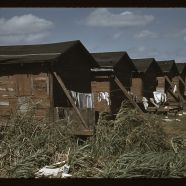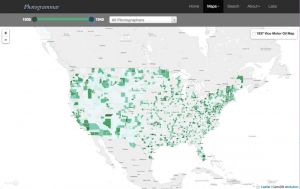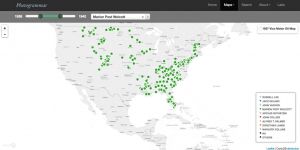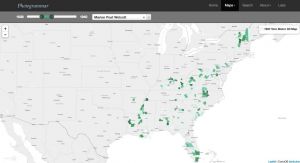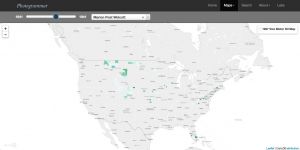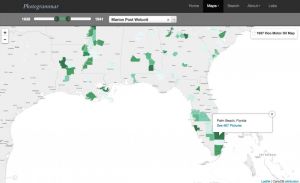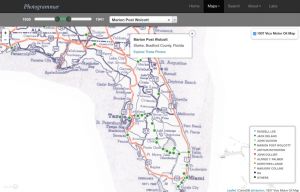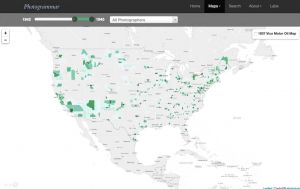“We’ve been lots of places”: Mapping the New Deal
Throughout the 1930s, the New Deal sat on precarious ground. The collection of government policies and resulting government agencies faced challenges from multiple fronts including concerned members of the public and politicians who lobbed accusations of socialism while the courts ruled aspects of the laws unconstitutional. In response, bureaucrats within the Farm Security Administration (FSA) set out to document America and the successful administration of new government services in order to build support for and to justify the programs during the Great Depression. The FSA charged the Historic Division with capturing a nation in need of and benefiting from the New Deal. Photographers were sent across the country sending more than 170,000 negatives to the nation’s capital. Among their ranks were prominent documentary photographers such as Arthur Rothstein, Dorothea Lange, Gordon Parks, Marion Post Wolcott, and Walker Evans. They produced some of the most iconic images of the era shaping visual culture in their moment and in American memory.
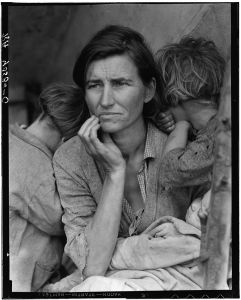
Destitute pea pickers in California. Mother of seven children. Age thirty-two. Nipomo, California. Photo by Dorothea Lange, 1936. http://photogrammar.yale.edu/records/index.php?record=fsa1998021539/PP
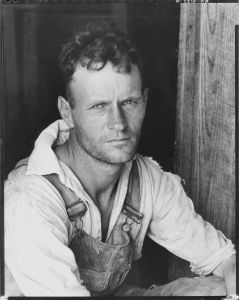
Floyd Burroughs, cotton sharecropper. Hale County, Alabama. Photo by Walker Evans, 1935. http://photogrammar.yale.edu/records/index.php?record=fsa1998020948/PP
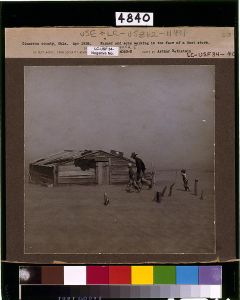
Farmer and sons walking in the face of a dust storm. Cimarron County, Oklahoma. Photo by Arthur Rothstein, 1936. http://photogrammar.yale.edu/records/index.php?record=fsa1998018983/PP
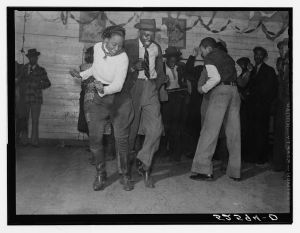
Jitterbugging in Negro juke joint, Saturday evening, outside Clarksdale, Mississippi. Photo by Marion Post Wolcott, 1939. http://photogrammar.yale.edu/records/index.php?record=fsa2000033025/PP
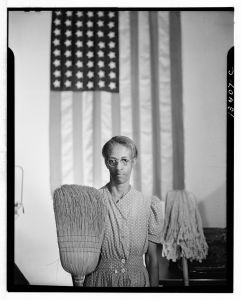
Washington, D.C. Government charwoman. Photo by Gordon Parks, 1942. http://photogrammar.yale.edu/records/index.php?record=fsa1998023725/PP
Shaped by the photographs that circulated in the 1930s and ensuing decades, the FSA photographs are often characterized as depicting the Dustbowl and American South during the New Deal years.
Mapping the collection through our interactive web-based platform Photogrammar offers two immediate insights. First, the map decenters the popular characterization of the collection indicating the geographical expanse of the agency and its continuation into the war years. The federal government transferred the Historic Division from the Farm Security Administration to the Office of War Information shortly after Pearl Harbor and charged the unit with depicting a nation ready for war. Roy Stryker and several photographers including Arthur Rothstein and John Vachon transitioned with the division.
Video of Arthur Rothstein Year by Year:
Second, interactive mapping allows us to filter and layer in new ways, a process we can observe by zooming in on Marion Post Wolcott.
Video of Marion Post Wolcott Year by Year:
Marion Post Wolcott’s photos by location by year. She began in 1938 and left the organization as it transitioned to the Office of War Information:
While her work is associated with the American South, she captured images across the country.
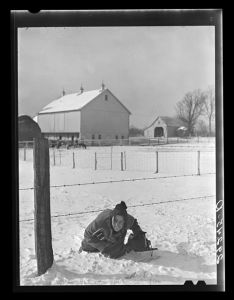
Marion Post Wolcott with Rolleiflex and Speed Graphic in hand in Montgomery County, Maryland. Library of Congress Prints and Photographs Division.
Marion Post Wolcott joined the FSA in fall 1938 after a brief stint as a freelance photographer. Her politics aligned with and shaped the organization. She was deeply committed to addressing and exposing economic inequality for social change, a conviction fostered through her experience teaching elementary education and participation in the New York Photo League. Among her first assignments included documenting Maryland’s Greenbelt, one of three cooperative communities planned and built by the Resettlement Administration. While she did not exclusively cover the American South, she focused on the region until 1941 when Stryker sent her West.
Wolcott photographs by county from 1938 through 1940.
Wolcott photographs during 1941.
Wolcott traveled throughout the South, returning to Florida over three years. She kept focusing her camera on the area around Belle Glade, a farming community about 45 miles west of West Palm Beach where migrant farmers labored in sweltering and exploitative conditions for meager wages.
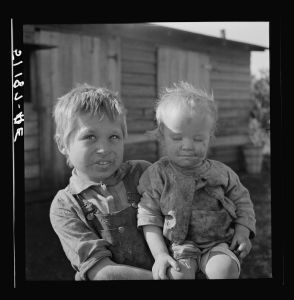
Migrant laborer’s children. Mother was thirty-two years old, had had eleven children, two sets of twins, six are now living. She and her husband lost jobs in packinghouse because they cut down in help or closed after the “freeze-out.” The older boy said “This little ‘uns fell off so since we come here. It was so fat before. It’s had colitis so bad. My daddy didn’t know we was comin’ to the wrong place this time. We’ve been lots of places. I don’t like it here so well but I reckon we’ll have to stay a smart while. My daddy had to turn back the car. He’d paid a lot off on it but he didn’t git enough work here. Now we can’t go nowheres else.” Belle Glade, Florida. Photo by Marion Post Wolcott, 1939. http://photogrammar.yale.edu/records/index.php?record=fsa2000031578/PP
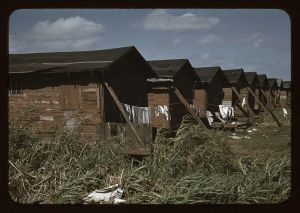
Houses which have been condemned by the Board of Health but are still occupied by Negro migratory workers, Belle Glade, Fla. Photo by Marion Post Wolcott, 1941. http://photogrammar.yale.edu/records/index.php?record=fsa1992001611/PP
In the same county, she contrasted the migrants’ conditions to those recently relocated to the FSA’s migratory labor camps, which provided affordable housing and social services including education and healthcare. Her photos and captions highlighted the critical role of the federal government in providing safe and healthy living conditions. Following segregation laws and practices, the FSA opened a camp among black migrants in Okeechobee and white migrants in Osceola.
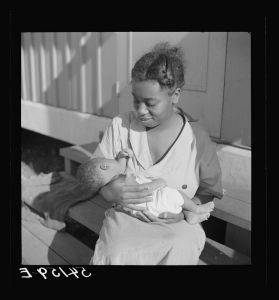
Mother of first baby born in Okeechobee migratory labor camp, where they have a nurse and clinic for prenatal care. Belle Glade, Florida. Photo by Marion Post Wolcott, 1940. http://photogrammar.yale.edu/records/index.php?record=fsa2000034641/PP
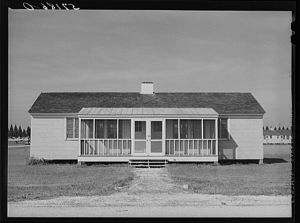
Labor home for agricultural workers in Okeechobee migratory labor camp. Belle Glade, Florida. Photo by Marion Post Wolcott, 1941. http://photogrammar.yale.edu/records/index.php?record=fsa2000037719/PP
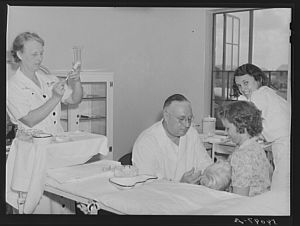
Dr. William J. Buck giving typhoid innoculation to child and mother, with Nurse Smock, and Marjory Fowler, NYA (National Youth Administration) camp member, assisting him. Osceola migratory labor camp. Belle Glade, Florida. Photo by Marion Post Wolcott, 1940. http://photogrammar.yale.edu/records/index.php?record=fsa2000034576/PP
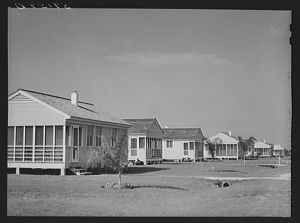
Labor homes for agricultural workers. Osceola migratory labor camp, Belle Glade, Florida. Photo by Marion Post Wolcott, 1941. http://photogrammar.yale.edu/records/index.php?record=fsa2000037696/PP
We can see the comparison between general migrant conditions and FSA migratory labor camps further highlighted by the way the federal government categorized her images. Each photographer was instructed to send their film back to Washington. More than 170,000 negatives were processed and 80,000 printed. The prints were categorized into two novel systems―Classifications and Lots―developed by librarian and curator Paul Vanderbilt. The Classifications system is what today we would call tagging. The hierarchical system begins with an initial tag such as “Organized Society” and then two more tags from subcategories are assigned such as “Government and Other Organized Aid” and then “Migratory Workers, Farm Labor Camps”. The schema allowed a way to search the photographs based on subjects determined by the government agency. The Lot system was organized around shooting assignments.
Wolcott’s photos in Belle Glade comparing and contrasting the living conditions among migrants were assigned to two lots. Lot 1586 includes 117 photographs throughout 1939 and depicts black and white tenant farming families navigating substandard living and labor conditions. In contrast, Lot 1592 focuses on the Okeechobee migrant camp and Lot 1593 on the Osceola migrant camp in 1940 and 1941. By creating two lots, the government agency replicated in the archive the segregation the photographs depicted.
Returning to the map, we can follow Wolcott along the roads she traveled in Florida. A small set of photographs from Starke, about 45 miles southwest of Jacksonville, offer the unexpected. A year before Pearl Harbor, Wolcott captures the conditions of construction workers building Camp Blanding, a training facility for the Florida National Guard. Like in Belle Glade, she highlights the conditions of laborers. For example, she contrasts the “living quarters of construction workers” with the “new sleeping quarters” funded by the federal government.
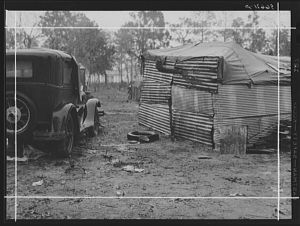
Living quarters of construction workers near Camp Blanding. Starke, Florida. Photo by Marion Post Wolcott, 1940. http://photogrammar.yale.edu/records/index.php?record=fsa2000037207/PP
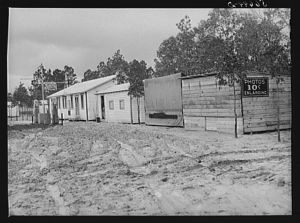
New sleeping quarters and cafe for construction workers near Camp Blanding. Starke, Florida. Photo by Marion Post Wolcott, 1940. http://photogrammar.yale.edu/records/index.php?record=fsa2000037235/PP
At the same time, the investment in military infrastructure suggests a government preparing for war at a time when the public sentiment remained isolationist. While the majority of the photographs in the set focus on the carpenters and construction workers, her photographs depict militarization in plain sight. The camp would become an army training facility during the war and later interned German prisoners or war.
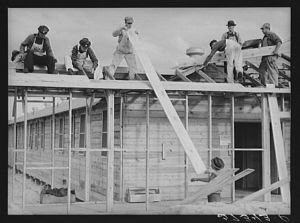
Construction of Army barracks at Camp Blanding. Starke, Florida. Photo by Marion Post Wolcott, 1941. http://photogrammar.yale.edu/records/index.php?record=fsa2000037871/PP
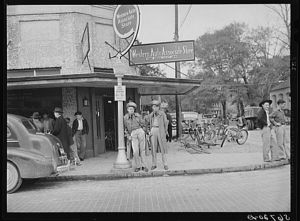
Soldiers on street corner in Starke, Florida. Photo by Marion Post Wolcott, 1940. http://photogrammar.yale.edu/records/index.php?record=fsa2000037256/PP
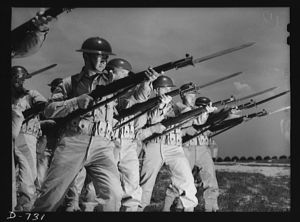
Members of Infantry Squad Company M, 12th Infantry, executing bayonet lunge or parry manuever. Arlington Cantonment, Arlington, Virginia. Photo by Marion Post Wolcott, 1941. http://photogrammar.yale.edu/records/index.php?record=oem2002000611/PP
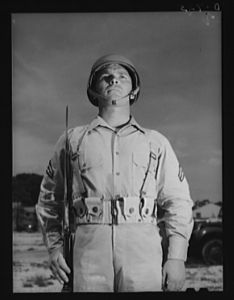
New Army helmet. Corporal French L. Vineyard, Company M, 12th Infantry, wearing a new Army helmet. Corporal Vineyard is wearing the combat pack and cartridge belt and is equipped with a Garand rifle with bayonet affixed. Photo by Marion Post Wolcott, 1941. http://photogrammar.yale.edu/records/index.php?record=oem2002000603/PP
Wolcott’s assignment in Virginia made explicit what her photographs from Starke suggested, that the government was preparing for war. She produced in May 1941 from the Arlington cantonment, a temporary military encampment in Virginia, some of her most staged photographs. Army Infantry members pose for the camera with staged lighting. The FSA’s transition from an arm of the New Deal to a propaganda machine for the Office of War Information was in motion.
While Wolcott left the division in late 1941 due to family obligations, several peers transitioned with the Historic Division, including Roy Stryker. The Historic Division would proceed to shift its focus to depicting a strong, affluent nation ready for war.
*A special thank you to Beverly Brennan and the Library of Congress for preserving and digitizing the FSA-OWI collection, and the National Endowment for the Humanities for supporting Photogrammar.


